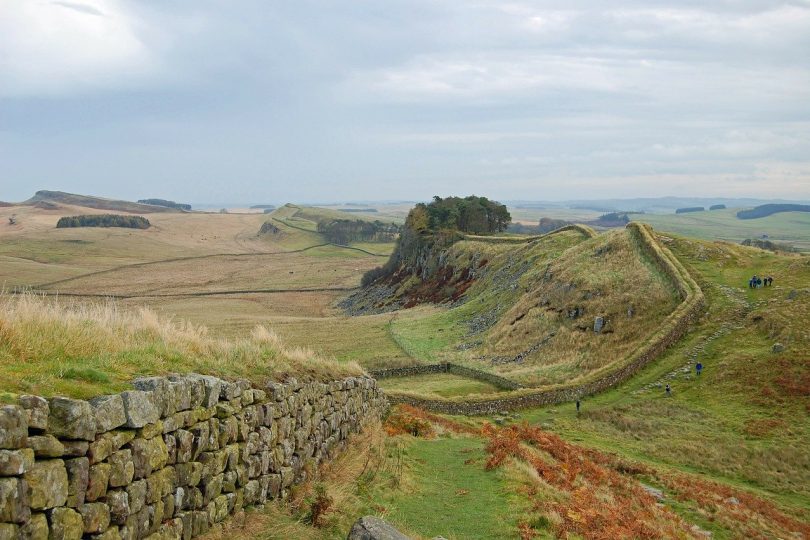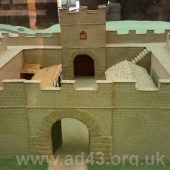The Breeze and Dobson award seeks to acknowledge the excellent research that is conducted in reference to Hadrian’s Wall and the Roman frontier by non-university researchers and early-career academics, and to encourage its publication and dissemination to a wider audience.
The Hadrian’s Wall Partnership Board is pleased to announce that Dr Katy O’Donnell has been awarded the 2021 Breeze and Dobson Award for her PhD project ‘The Quarries of Hadrian’s Wall’.
Dr O’Donnell completed her undergraduate, masters and PhD at the University of Edinburgh beginning in 2010. She submitted her masters by research dissertation ‘The Quarries of the Central Sector of Hadrian’s Wall’ in 2015. During her MSc she became very interested in quarrying, landscape archaeology and geoarchaeology. She started her PhD in Classics in 2016 with the topic ‘The Quarries of Hadrian’s Wall: Materials & Logistics of a Large Scale Imperial Building Project’ with funding from the Arts and Humanities Research Council, under the supervision of Prof. Jim Crow and Dr Ben Russell. Since graduating, she has been working with the Hadrian’s Wall Community Archaeology Project (WallCAP) as a research associate and with CFA as a post-excavation archaeologist.
Dr O’Donnell summarizes her award-winning research as follows:
‘Project aims:
My thesis examined the stone sourcing process for the construction of Hadrian’s Wall. It was necessary to understand the entire history of the region in order to establish which of the many quarries may have been associated with the Roman Wall, due to very limited changes in quarrying techniques up to the modern era. There are currently only 7 confirmed Roman quarries at Hadrian’s Wall. These were the most important research questions I focused on –
• How can Roman quarries be identified through evidence in the field?
• Where did the stone come from and how effective is petrological testing in determining the stone sources of Hadrian’s Wall?
• How much stone was required, and are the known Roman quarries large enough to supply the entire construction of the Wall?
Project methods:
Looking at land-use, historical mapping and industrial and pre-industrial quarrying methods has allowed a categorisation of the quarries to suggest which, if any, of the undated sites are the most likely to be associated with the Roman Wall. A gazetteer of 152 of the quarries has been produced which includes all the data gathered for this research.
This research also completed the largest scale petrological testing programme ever completed along Hadrian’s Wall. Ninety-three samples were taken in total, thirty-seven samples from archaeological remains and fifty-six quarry samples. Samples have been taken from six archaeological sites, thirteen quarries and five control locations. XRF, and thin-section microscopy were used to identify links between the archaeological sites and potential stone sources.
Project Results and Implications:
One of the most surprising results is that there are not enough sandstone quarries (of any date) within a 10 km buffer zone of the Wall to supply the construction of the Wall. This means there are likely to be alternative stone sources, including the ditch, rubble from the Whin Sill, destroyed quarries under Newcastle and Carlisle, or possibly quarries further than 10 km away. The yield estimate for the Roman quarries coincides well with the total volume of stone needed for the facing stone of the curtain Wall. A volume of 216,579 m3 was required for the facing stones, and the three largest quarries could have supplied 92% of this.
With the petrological testing the goal was to determine if the testing could distinguish between different quarries, and while the XRF did show some distinction between the various quarries, it was not accurate enough to narrow it down to a specific site in most cases.
One of the quarries which was sampled was an excellent match both in thin section and in XRF, and this quarry (although suspected to be Roman) has no inscriptions and is not currently protected. It may be possible in the future to identify more quarries through these methods and have them recognised through official mapping of the Wall.
This research and the data collected (in the gazetteer and the collection of thin section photomicrographs) feeds well into new and larger studies on Hadrian’s Wall like the Hadrian’s Wall Community Archaeology Project and hopefully other future research.’

